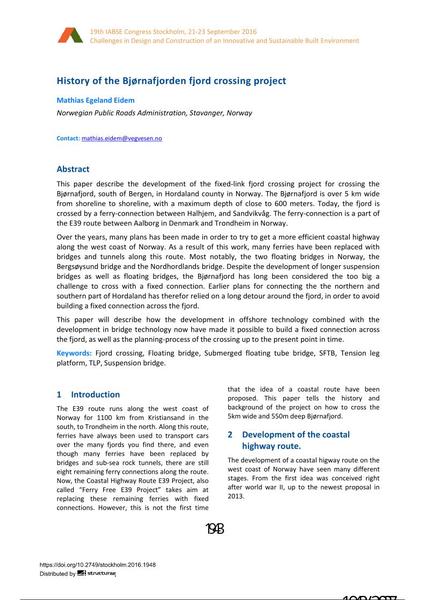History of the Bjørnafjorden fjord crossing project

|
|
|||||||||||
Bibliographic Details
| Author(s): |
Mathias Egeland Eidem
(Norwegian Public Roads Administration, Stavanger, Norway)
|
||||
|---|---|---|---|---|---|
| Medium: | conference paper | ||||
| Language(s): | English | ||||
| Conference: | IABSE Congress: Challenges in Design and Construction of an Innovative and Sustainable Built Environment, Stockholm, Sweden, 21-23 September 2016 | ||||
| Published in: | IABSE Congress Stockholm, 2016 | ||||
|
|||||
| Page(s): | 1943-1950 | ||||
| Total no. of pages: | 8 | ||||
| Year: | 2016 | ||||
| DOI: | 10.2749/stockholm.2016.1948 | ||||
| Abstract: |
This paper describe the development of the fixed-link fjord crossing project for crossing the Bjørnafjord, south of Bergen, in Hordaland county in Norway. The Bjørnafjord is over 5 km wide from shoreline to shoreline, with a maximum depth of close to 600 meters. Today, the fjord is crossed by a ferry-connection between Halhjem, and Sandvikvåg. The ferry-connection is a part of the E39 route between Aalborg in Denmark and Trondheim in Norway. Over the years, many plans has been made in order to try to get a more efficient coastal highway along the west coast of Norway. As a result of this work, many ferries have been replaced with bridges and tunnels along this route. Most notably, the two floating bridges in Norway, the Bergsøysund bridge and the Nordhordlands bridge. Despite the development of longer suspension bridges as well as floating bridges, the Bjørnafjord has long been considered the too big a challenge to cross with a fixed connection. Earlier plans for connecting the the northern and southern part of Hordaland has therefor relied on a long detour around the fjord, in order to avoid building a fixed connection across the fjord. This paper will describe how the development in offshore technology combined with the development in bridge technology now have made it possible to build a fixed connection across the fjord, as well as the planning-process of the crossing up to the present point in time. |
||||
| Keywords: |
suspension bridge floating bridge fjord crossing Submerged floating tube bridge SFTB Tension leg platform TLP
|
||||

